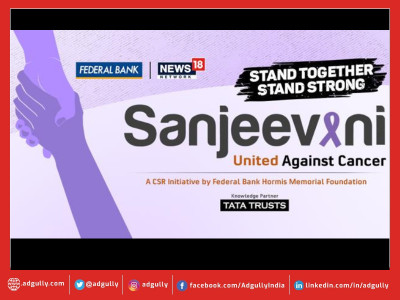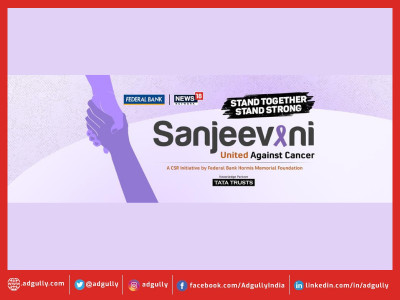Tata Trusts’ digital-led approach to creating social awareness about cancer
Every year more than 14 lakh new cases of cancer get detected in India, and over 70% of cancer cases in the country result in death due to late detection. With the theme – ‘Closing the Care Gap’, World Cancer Day, observed on 4th February 2023, advocates access to cancer care for all.
Tata Trusts, one of the oldest philanthropic organisations, has been working towards bridging the cancer care gap in India through its cancer care interventions since 1941 when the Tata Memorial Hospital opened in Mumbai. It works closely with state governments to operationalise screening programmes for oral, breast and cervical cancers and implement interventions in cancer care around the country.
In keeping with the theme of ‘Closing the Care Gap,’ Tata Trusts will be launched a three-film campaign titled – ‘Kaise ka Cancer’. The films further create awareness of the support and resources provided by Tata Trusts to help reduce the cancer burden in the country.
In conversation with Adgully, Deepshikha Goel Surendran, Head of Brand and Marketing Communications, at Tata Trusts, shares a few insights about the launch of the campaign and how the brand is willing to spread awareness amongst people via this campaign.
Why does the 'Kaise ka cancer’ campaign' matter to India?
Tata Trusts, the pioneer in cancer care in India, is taking yet another step to #closethecaregap through the launch of its latest campaign ‘Kaise Ka Cancer.’ The campaign brings to the fore the uncertainty, the helplessness and anxiety that cancer patients and their families experience, when the disease is detected. An average Indian, not residing in a large metro city, is more bogged down by the inaccessibility to quality care and the associated travails that he must face first, when detected with cancer, before even thinking about going through the treatment itself. This typically happens because quality cancer care is focused on a few metro cities which also unfortunately leads to a large load on these hospitals, thereby compounding the problem.
#KaiseKaCancer endeavours to create awareness around these deeper issues of access, affordability, and quality care around cancer, in India. The objective of this campaign is to assure the citizens of India that quality and affordable care is closer to home, and their focus now needs to be on getting treated and recovering vs worrying about the associated issues when quality care is inaccessible.
The 3-film campaign highlights not just a patient’s state of mind when detected with cancer in the first film but also uncovers the anguish of their family and the challenges faced by them in the second film from the series. The third film nudges people to not be dismissive of symptoms and to get themselves tested and screened.
Through sensitive storytelling, the campaign brings hope and reassurance that there is a light at the end of this tunnel. The insight will be carried forward to other mediums for higher reach and impact.
What is the creative thought process behind the 'Kaise ka cancer’ campaign'?
The campaign is the result of an extensive qualitative research that was conducted across several cities comprising focused group discussions (FGDs) and direct interviews (DIs). We met cancer patients and their families and went through heart-wrenching accounts of their journey from disease discovery to disease recovery, especially in smaller towns where our hospitals are coming up. The insight ‘kaise’ is a creative articulation of the plethora of questions faced by a patient and his family when the disease strikes. The film addresses not just a cancer patient’s plight but also that of his family who constantly worry about the wellbeing of their loved one. We also discovered the widely prevalent ignorance of cancer symptoms that primarily result in late detection and consequently poor survival rates resulting in greater fear of the disease.
The campaign supports the Trusts efforts to ‘flip the ratio’: worldwide 30% cancers are detected late (with dim chances of recovery) but in India this percentage sits at 70% *. One hopes that with higher awareness, more lives can be saved with the simple act of screening and testing. Through our third film we want to showcase the need to pay attention to symptoms such as difficulty in swallowing, lumps, mouth ulcer and unusual vaginal discharge and highlight the importance of getting checked and tested – an imperative measure in India, where the already high disease burden is exacerbated due to delayed detection.
What according to you does the cancer care ecosystem in India look like and the importance of boosting early detection?
India has a huge burden of cancer. Every year, over 14 lakh new cases are reported in the country. Around 70% of these cases are diagnosed at a very late stage, resulting in high cancer mortality, estimated to be as high as 70%. This is in stark contrast with the developed countries, where the cancer mortality rate is less than 30%.
Cancer care in India is concentrated at tertiary hospitals and major cancer centres in urban areas with gaps in infrastructure and human resources that, among other factors, hinder delivery of high-quality cancer care. The patients often have to travel far to seek treatment and care, leading to high out of pocket expenses. Out of pocket (OOP) expenditure on cancer hospitalisation is about 2.5 times of overall average hospitalisation expenditure, many times leading to high dropout rates along the treatment pathway.
Nationwide, well-organised screening, detection, and prevention programmes are few and far in between. Screening programmes are aimed at identifying cancer before the symptoms develop. When abnormalities are identified during screening, further tests are carried out for a definitive diagnosis. Boosting screening programmes will make it possible to identify cancer cases in pre-cancerous to early stages, thus making it possible to treat and save lives.
What were Tata Trusts’ cancer efforts and how did the campaign empower patients?
Tata Trusts introduced the Cancer Care Programme to transform cancer care in India. The objective is to provide access to quality, affordable and compassionate care to millions of Indians, closer to their homes. A network of hospitals equipped with comprehensive diagnostic and full-fledged treatment facilities is being set-up.
Community outreach teams have been put in place for early detection of cancer. Awareness is being created for signs and symptoms of most common cancer types, and measures to be taken to reduce the risk of the disease. In collaboration with multiple chapters of National Rural Health Mission, community awareness and screening are carried out. Frontline workers of Primary Health Centres (PHCs) and Health and Wellness Centres (HWCs) are being trained for screening and awareness. Community Based Organizations and Self-help groups are being engaged across states.
What are the distribution and media mix strategies for this campaign?
#KaiseKaCancer is a multimedia, multilingual campaign that will be phased out over the next few months. The approach is digital-first with amplification across traditional and local media. This will be supported by our philanthropic Community connect and activations in areas where our hospitals are coming up. Given the significance of the cause, we are hoping like-minded partners will join us in this all-important journey to create a cancer-free India.

















Share
Facebook
YouTube
Tweet
Twitter
LinkedIn